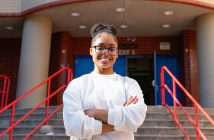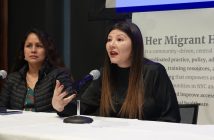If teachers, parents and administrators want students to succeed at life as well as academics, they must devote their energy to more than just standardized testing.
That was the overriding message of “Caring Adults/Caring Environments: What Works in Schools and Beyond,” a daylong conference held on June 10 at Fordham’s Lincoln Center campus.

Jonathan Cohen Photo by Patrick Verel
Keynote speaker Jonathan Cohen, Ph.D., president and co-founder of the Center for Social and Emotional Education at Columbia University’s Teachers College, compared the transformation of schools into more caring places to the changes that compel an infant to walk for the first time.
When he asks parents what they want their children to know as they graduate from high school, he said the answer usually has little to do with academics.
“People want their children to be able to find a mate, to be able to discover their passions, to be able to get a job and to participate in the community,” he said. “In a way, it’s to be able love and to work, to really connect with people in caring and collaborative ways.”
A major obstacle, he said, is that despite many opinions to the contrary, there is a large number of students who are too fearful for their safety to learn.
“In some classes, kids are not supposed to act smart. In some classes, teachers bully kids,” he said to murmurs of approval from the crowd in Pope Auditorium. “This is upside down, and yet we’re not tracking this.”
“The single most common finding that we discover is that adults tend to say that social safety is a problem, but it’s in the mild to moderate area. Kids, in virtually every school say that feeling unsafe is a major problem.”
A single expression of interest in a student by an adult, such as greeting them at the front door every morning, can have a profound effect, Cohen said, by making it easier for the student to feel comfortable talking to administrators.
He also suggested an exercise for educators who want to begin the process in their own schools. Students’ names are written on file cards, which are then tacked to a bulletin board. Teachers, safety agents and secretaries are given dots, and they put a dot next to any student to whom they feel really connected.
“In half an hour, depending on the size of the school… boom. We see who are the students who have no dot, who are not connected to any adult,” he said.
The conference was sponsored by the Task Force on School and Community Collaboration—NYC Interagency Committee and hosted by the Fordham University Graduate School of Education.


